#Arnie Swekel
Photo
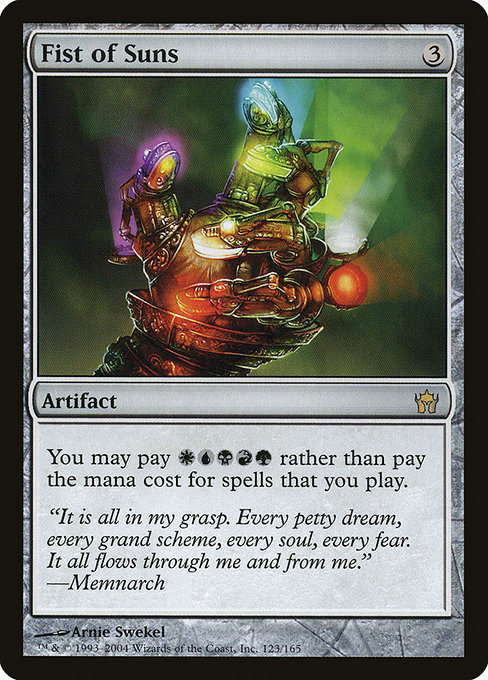
Fist of Suns
"It is all in my grasp. Every petty dream, every grand scheme, every soul, every fear. It all flows through me and from me." —Memnarch
Artist: Arnie Swekel
TCG Player Link
Scryfall Link
EDHREC Link
49 notes
·
View notes
Text

It's good to be the king. It's better to be a dragon-mage clan lord. (Arnie Swekel pencils and design, and Glen Angus ink, from Council of Wyrms, AD&D 2e boxed set with rules and unique campaign setting for playing dragons as PCs, written by Bill Slavicsek, TSR, 1994)
#D&D#Dungeons & Dragons#Arnie Swekel#Glen Angus#dragon#Council of Wyrms#Bill Slavicsek#dnd#fantasy#fantasy art#gold dragon#dragon hoard#treasure hoard#treasure#half dragon#D&D 2e#AD&D 2e#TSR#Dungeons and Dragons#1990s
159 notes
·
View notes
Photo


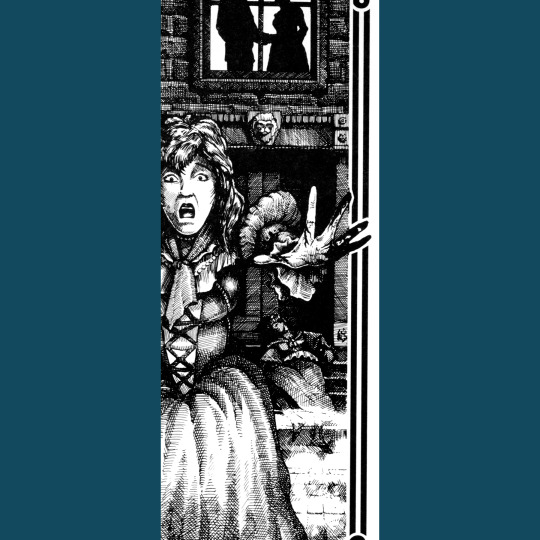
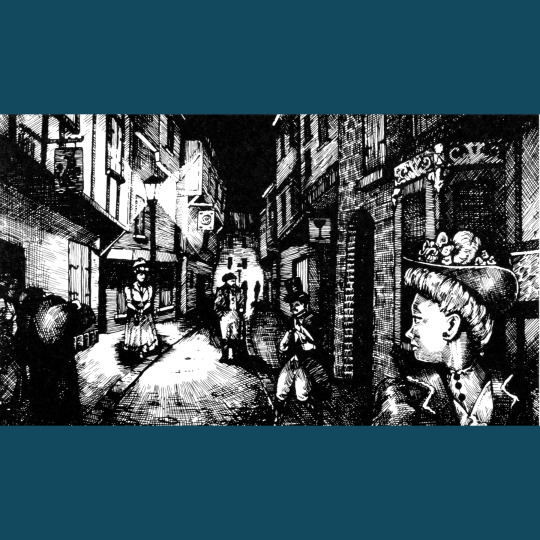


This is Hour of the Knife (1994). Weird cover! That’s a John and Laura Lakey jam. I gotta say, Ravenloft has, pretty much from House on Gryphon Hill, flirted with the faux-Victorian aesthetics of Universal and Hammer horror films. It is refreshing to have this cover just embrace it. More bowler hats in fantasy, pls. Arnie Swekel on the interiors. He’s not Stephen Fabian, but I’m not gonna complain. Just gonna point out he isn’t Fabian (I love Arnie’s work, I’m just funnin’).
So, I love this adventure. It’s an open-ended investigation (honestly don’t understand why there isn’t more of this in the Ravenloft line, but there isn’t really). As you can guess from the name and the cover art, there’s a murderer loose and the players need to find the clues to bring him and his evil knife to justice. There is a very large (though strangely bland) city map to aid in the detective work. There are annoying things (death fake outs are the worst) but overall, this is a bit of much needed freshness. It doesn’t last, but eh, whatever, nothing does.
#RPG#TTRPG#Tabletop RPG#Roleplaying Game#D&D#dungeons & dragons#Ravenloft#Hour of the Knife#Arnie Swekel#Lakey
61 notes
·
View notes
Text

Hollow Dogs (Seventh Edition) - Arnie Swekel
5 notes
·
View notes
Text
so hard to figure out who did what illustration in these old dnd books when there's several interior artists
in regards to i, tyrant, since thats my favourite
i know whose are david martin, randy post, and william o'connor since theyre signed. and then there's 2 other. i think the ones in color are arnie swekel, so i think glen michael angus did the cool cross hatched ones
im curious cause like. i love those cross-hatching illustrations and i want to give credit where credit is due. id love to be able to draw in this style. i also adore the way david martin colors his and the way he draws beholders
4 notes
·
View notes
Photo
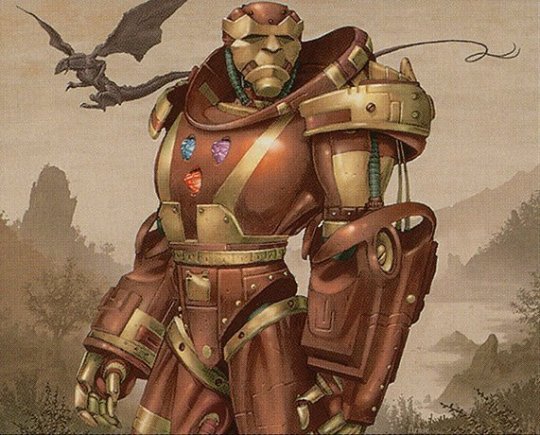
Crosis's Attendant by Arnie Swekel
#Magic the Gathering#MtG#Invasion#Dominaria#Crosis's Attendant#Artifact Creature#Fantasy#Art#Arnie Swekel
5 notes
·
View notes
Photo

3 notes
·
View notes
Text
Qlippoth, Rutterkin
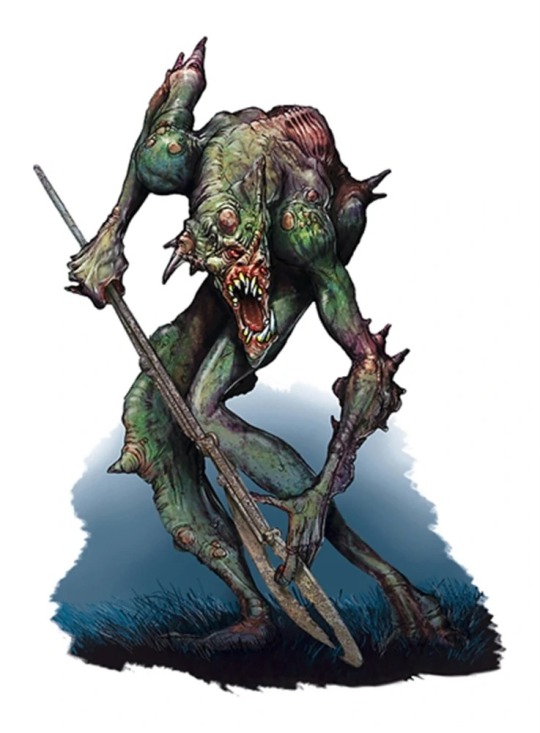
Image by Arnie Swekel, © Wizards of the Coast
[It appears that the D&D 3.x Art Gallery sites have finally been taken down from the Wizards of the Coast web servers. RIP.
The rutterkin is a monster I’ve used in the past, but never with any real enthusiasm. Mordenkainen’s Tome of Foes finally gives them a mechanical hook, in that they’re contagious. This, combined with their grotesque appearance, made them seem a good candidate for shifting over to the qlippoth camp from its original demon designation. The mechanics here are a combination of ideas from rutterkins throughout the editions.]
Qlippoth, Rutterkin
CR 4 CE Outsider (extraplanar)
This humanoid creature is hideously twisted and warped, its limbs jutting at odd angles and its head pointed. Its large teeth are crooked and sharp. It carries a strange forked polearm, and has several other weird weapons arrayed on its back and shoulders.
Rutterkin are the foot soldiers of Yamasoth the Polymorph Plague. This qlippoth lord has long sought to prevent the influx of mortal souls into the afterlife by transforming creatures into qlippoth directly, or into beasts or plants with minor, unaligned souls. The rutterkins are the success story of these efforts, a wide-ranging and contagious horde of vaguely humanoid qlippoth. Any creature bitten by a rutterkin is cursed with painful disfigurement as its flesh creeps as if alive, and if a humanoid dies under this influence, it transforms into a new rutterkin.
In combat, rutterkin attempt to spread their curse as much as possible. They have spell-like abilities that help them maneuver around a battlefield and control the movement of their enemies, but once they have deployed these, they charge headlong into battle. Rutterkin wield weapons with ease—their favorites are polearms, chakram and swords. Rutterkin delight in revealing their full awfulness, which strikes creatures with so much disgust that they tear at their own bodies in revulsion.
Rutterkin are bullies and thugs, and especially enjoy picking fights with weak demons such as dretches, quasits and abrikandilu. Although stronger and smarter demons often hunt rutterkin for sport, an infestation of them can blight an area for a long time. Even if a gang of rutterkin is wiped out, their chaos phage can linger in the background before erupting into a new wave of aberrant horrors. Their violence is sometimes coordinated by a more intelligent qlippoth like a shoggti or utukku.
Rutterkin CR 4
XP 1,200
CE Medium outsider (chaos, evil, extraplanar, qlippoth)
Init +2; Senses darkvision 60 ft., Perception +9
Defense
AC 18, touch 12, flat-footed 16 (+2 Dex, +6 natural)
hp 37 (5d10+10)
Fort +6, Ref +6, Will +2
DR 5/lawful; Immune cold, mind-influencing effects, poison; Resist acid 10, electricity 10, fire 10; SR 15
Offense
Speed 20 ft.
Melee guisarme +7 (2d4+3), bite +5 (1d6+1 plus chaos phage), or 2 claws +7 (1d4+2), bite +7 (1d6+2 plus chaos phage)
Ranged chakram +7 (1d8+2)
Space 5 ft.; Reach 5 ft. (10 ft. with guisarme)
Special Attacks horrific appearance
Spell-like Abilities CL 4th, concentration +6
3/day—darkness, fly
1/day—dimension door, telekinesis (DC 17)
Statistics
Str 15, Dex 14, Con 15, Int 9, Wis 12, Cha 15
Base Atk +5; CMB +7; CMD 19
Feats Multiattack, Power Attack, Quick Draw
Skills Acrobatics +10 (+6 jumping), Craft (weapon smith) +7, Intimidate +10, Perception +9, Stealth +10
Languages Abyssal, telepathy 100 ft.
Ecology
Environment any land or underground (the Abyss)
Organization solitary, pair or gang (3-12)
Treasure standard (guisarme, 5 chakram, other treasure)
Special Abilities
Chaos Phage (Su) Curse—injury; save Fort DC 14; onset immediate;; effect -6 Cha penalty and sickened; duration permanent until save is made. A creature suffering from the chaos phage curse can make a new DC 14 Fortitude save every 24 hours. If a humanoid, monstrous humanoid or native outsider dies while suffering from the chaos phage, it transforms into a free willed rutterkin in 1 minute. The save DC is Charisma based.
Horrific Appearance (Su) range 30 ft.; save Will DC 14; effect dazed 1 round and takes 1d8 points of damage plus the creature’s Strength bonus. The save DC is Charisma based.
27 notes
·
View notes
Text

Haunted Angel - Angel
2W - 3/3
Flying
When Haunted Angel dies, exile Haunted Angel and each other player creates a 3/3 black Angel creature token with flying.
illustrated by Arnie Swekel
2 notes
·
View notes
Text
Card of the Day: Berserk Murlodont

I want to start with the fact that I read this as “Berserk Murderlont” which I hold is a great name that must be used.
So this card has a weird hybrid of Bushido or Rampage, and I kind of like Murlodont’s ability. A 3/3 for 5 isn’t great, but a 3/3 that can’t be chump blocked? That’s fun to me.
Also, mathwise - no amount of 1/1s will kill this. That makes this stronger than Emrakul in certain situations, which helps it pass the Shuckle Principle. (The Shuckle Principle being that Shuckle is the strongest Pokémon in the world, in a very specific set of circumstances).
2/2s, on the other hand? One 2/2 is blocking a 4/4. Two is blocking a 5/5. Three is blocking a 6/6. Three zombie tokens or three bears kills one Murlodont.
Also, look at that horrible, nonsensical mouth! Arnie Swekel, you did a great job!
You know what, I’m not even evaluating this one. It’s fantastic.
Okay, I lied. There is another common that’s strictly better - Rabid Elephant from Odyssey. 3/4, same mana cost, and it has a stronger version of this power. But one’s just an elephant that got bit by a dog (I looked it up, that’s how elephant rabies happens). This one is a giant, lizardy doofus.
I would probably let this guy wheel, but it can be a lot of fun in the right draft environment. Put it in your Strictly Worse Cubes.
6 notes
·
View notes
Text
Cats of the Multiverse
When Commander (2017 Edition) was announced, you probably didn’t guess that Cat would be one of the featured tribes. When you found out that Cat would be one of the featured tribes, you probably didn’t think that there would be enough cards for the deck. When the decklists were finally revealed, you probably didn’t think that there was going to be that many different kinds of cats in the Multiverse.
And yet there are over twenty unique kinds of cat in Magic.
Last week I broke down the biodiversity of dragons by categorizing them up by plane. Many of the types of cats show up on multiple planes, so today’s article is going to be organized by type of cat instead. Pull up a box that you fit into, curl up and nap for twelve hours, and read on once you wake up.
Arahbo

Arahbo, Roar of the World by Jesper Ejsing
We only just learned that Arahbo exists, but he is already the most unique cat in Magic. Similar to how The Ur-Dragon imbues the Multiverse with dragonkind, Arahbo is the Ur-Cat that rouses the ferocious spirits of cats everywhere. We don’t know if they dwell on any specific plane or are an avatar capable of manifesting anywhere.
Arahbo has stripes like a tiger, a cloak-like mane echoing lions, and physical size to match any of the monstrous cats of the Multiverse.
Cat Warriors
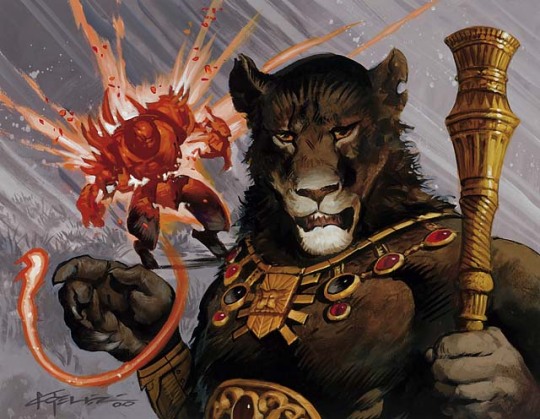
Planeswalker’s Fury by Christopher Moeller
Cat warriors are the generic name given to most anthropomorphic cats in Magic. They are inspired by many kinds of real-world cats. Jedit Ojanen is a tigerfolk from Dominaria. The Planeswalker Windgrace (pictured above) was a black panther cat warrior who lived in Urborg. Jaguar-like cat warriors are members of the nacatl tribes on Alara. The only cat that doesn’t fall under the “cat warrior” umbrella is the lion, which belong to the named leonin race.
It’s possible that these different species of cat warrior get unique race names in the future. Until that day, they all get lumped together in one group.
Nekoru

Wasitora, Nakoru Queen by Cynthia Sheppard
While most cats are small and fuzzy, the nekoru of Jamuraa are giant cat-dragons. They have black fur and basically look like panthers with dragon wings.
Their most important role in Dominaria’s history was when Wasitora was stationed in Madara to protect the empire in exchange for fish. This was in the same era centuries ago when Tetsuo Umezawa killed Nicol Bolas, but the nekoru still live in their adopted home today.
Nishoba

Arctic Nishoba by Dave Kendall
There really isn’t much lore about the nishobas of Dominaria. What we know about them is inferred from their cards. They are massive, sabertoothed individuals. All the nishobas have such large power and toughness that they’re clearly some of the largest humanoids in the Multiverse. Sabertooth Nishoba even depicts one fighting a relatively small looking sea serpent.
Leonin

Pride Guardian by Chris Rahn
Leonin are the specifically leonine catfolk of the Multiverse. While they were first seen on Mirrodin, they only existed there because Memnarch stole them from somewhere else. Leonin have also appeared on Alara and Theros.
If you know what one leonin looks like, you know what they all look like. They display the standard sexual dimorphism, with males bearing large manes. Leonin look basically the same everywhere, though there are a few local quirks. Alaran leonin have coats colored in the standard gold, but can be white, grey, or black too. Like all other organisms on Mirrodin, leonin there have metal plating and dreadlock-esque hair.
Most cats are associated with both Green and White mana, but leonin are almost exclusively associated with White mana.
Rakshasa
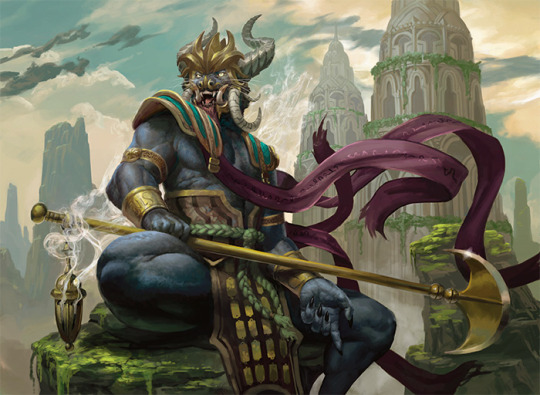
Rakshasa Vizier by Peter Mohrbacher
The rakshasa of Tarkir are tiger-esque demons that lust for power and influence. They’re centered in Black, but occasionally tap into Green and Blue mana. They wield dark magic and are willing to share…for a price.
Whether in the Tarkir of Sarkhan’s nonexistent past or the Tarkir ruled by dragons, rakshasa tend to influence events from the shadows rather than the spotlight. Their large forms are often hunched over, whispering blackmail and treachery to those unfortunate enough to be in their debt.
Besides being large tigerfolk, rakshasa sprout curling demonic horns. They often wear ornate headdresses that reflect both their greed and the intricate loopholes in their pacts.
Housecat

Sacred Cat by Zezhou Chen
Not all cats are sapient humanoids. There are plenty of animalistic cats around.
The first group is exceptionally familiar: the housecat. Many planes have regular little cats that mew and catch mice and knock over goblets of ale. We’ve seen the most housecats on Innistrad, Ravnica, and Amonkhet.
Like most creatures in the Multiverse, not even housecats are immune to zombification. Zombies are everywhere on Innistrad, while cats on Amonkhet have been embalmed as part of Nicol Bolas’s Eternal army.
Small Wildcat

Steppe Lynx by Nic Klein
Wildcats come in many shapes and sizes, but they can be generally organized into small cats and large cats. These tend to be real-world animals put into a magical setting. Most of the small wildcats are lynxes (bobcats are lynxes), though there are a few caracals in Magic too. Some of the caracals are even domesticated, but they’re still much larger than the average housecat.
Debate can rage over whether or not pumas/cougars are small or large wildcats. Magic has a few either way.
Big Wildcat

Scythe Tiger by Michael Komarck
Big wildcats are like small wildcats but bigger. If you think pumas are big cats, then they’re here instead of in the last group (Though the Guma, which I can only assume is a portmanteau of “giant puma,” is definitely in the large group.)
These are familiar animals: lions, tigers, leopards, cheetahs, jaguars, and sabertooth cats. Panthers are just leopards or pumas or jaguars in our world, so it’s unknown if they’re an actual unique species in Magic.
A fantasy property has no problems making animals a little more fantastic. Some leopards have scythes on their legs. Some cheetahs have horns. Krosan Vorine is a generic “big cat” except for the spikes on its elbows and tail.
Firecat

Blistering Firecat by Arnie Swekel
Sometimes cats are just on fire.
Elemental cats wreathed in flame can mostly be found on Dominaria, but they also appear on Regatha and Fiora. They tend to be superficially built like large wildcats.
That’s it. They’re big cats made out of fire. Pretty easy to grok.
Jhovall
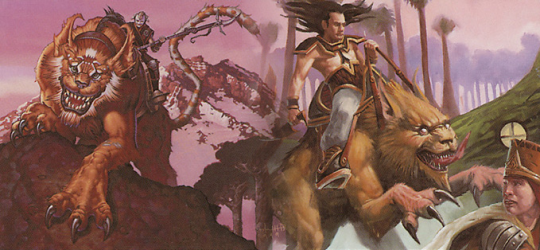
Jhovall Queen by Michael Sutfin and Jhovall Rider by Scott M. Fischer
The plane of Mercadia is the home of the giant jhovalls. These cats are tiger-like in appearance, but have one key distinguishing feature. Jhovall ears are long and end in curved points. Fancy.
While jhovalls are wild animals, they can be domesticated. Rebel forces on Mercadia often use jhovalls as mounts. The size and strength of these felines make them invaluable partners in combat.
Leotau
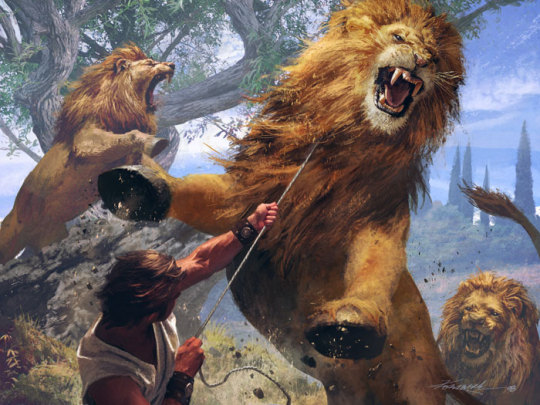
Wild Leotau by Michael Komarck
Mercadians aren’t the only people in the Multiverse who ride on weird fantasy cats. Leotau are hooved lions that (mostly) reside on the Alaran shard of Bant. Their stout, muscular bodies make them ideal mounts for the heavily armored knights of the plane. Leotau themselves even wear armor, participating in the regality of Bant’s martial culture.
While the only living leotau that survived the Sundering reside on Bant, zombified leotau still roamed the nightmarish shard of Grixis. These skeletal beings have replaced the pomp of their fleshy siblings with undying horror.
Felidar
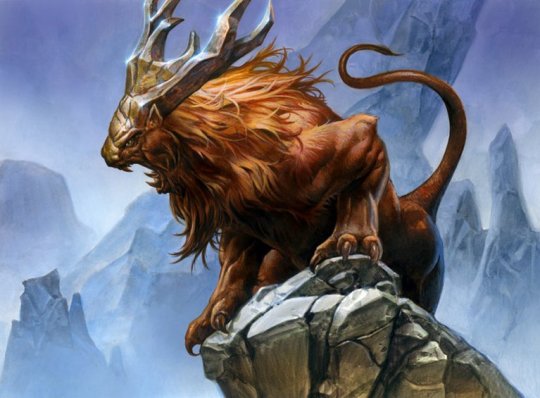
Felidar Sovereign by Zoltan Boros & Gabor Szikszai
The bestial felidar are large cats crowned with crystalline horns. They are native to two planes: Zendikar and Kaladesh. Felidar of each plane have slightly different characteristics.
On Zendikar, felidar have muscular bodies and thick coats. Their horns glow with White mana, blinding foes as they charge into battle. They are often ridden by wandering knights, continuing the motif of noble wildcats acting as mounts.
The felidar of Kaladesh are lithe and elegant. Their white coats and bright blue stripes mirror the aether that imbues all life on the plane. Their horns swirl like fine filigree.
Maaka

Rubblebelt Maaka by Eric Velhagen
We know almost nothing about the maaka of Ravnica. They’re gigantic wildcats with six eyes that roam in the ruined regions of the city. They’re aligned with the Gruul Clans, attacking any foreign forces unfortunate enough to wander into maaka territory.
Arynx

Lurking Arynx by Carl Frank
Likewise, we know almost nothing about the arynx of Tarkir. They prowl the forests across the entire plane, from the humid jungles in Silumgar’s domain to the coniferous woodlands of Atarka’s hunting grounds. Predators have to be ferocious and violent in a world ruled by dragons, and the arynx is no slouch. Large fangs, facial spikes, and elbow blades allow these cats to kill large game. They have elongated ears, which probably help locate and track prey over large distances.
Bandar

Scrounging Bandar by Shreya Shetty
The sneakiness of a cat with the mischief of a monkey. That is the duality of the bandar.
These literal cat-monkeys live on Kaladesh, where they’re a nuisance to artificers everywhere. Bandar frequently take tools, munch metal, and wreck workshops.
Longtusk

Longtusk Cub by Zoltan Boros
The longtusks are a wildcat of Kaladesh that are heavily influenced by the movement of aether in the ecosystem. Aether’s swirling patterns can be found in many places in longtusk anatomy. Their tails curl with the aether currents. Their stripes undulate with the aethersphere. Even their namesake tusks growing in a swirling shape as they age.
It’s just a shame those teeth prevent the longtusks from actually being able to access food with their mouths.
Serpopard

Prowling Serpopard by Tyler Jacobson
Serpopards are part snake, part cat. They hunt in the deserts of Amonkhet, hiding in oasis trees to drop onto unsuspecting prey. They have the venomous fangs and sensory tongue of a serpent and the stealth and cunning of a leopard. Like many of the plane’s beasts, serpopards are occasionally brought into Naktamun to become part of Rhonas’s menagerie.
Magical Cats

Nylea’s Emissary by Sam Burley
Aside from the flaming elemental felines, there are all sorts of magical cats throughout the Multiverse. They are as varied as the biomes they inhabit and as mysterious as the energies that create their bodies.
These cats can be made from just about anything; ice, Phyrexian engineering, crystals, illusion magic, clouds, ghosts, Nyx, stone, barbed wire, and the spirit of night itself. So long as Magic continues to explore the Multiverse, I’m sure even more magical cats will be discovered.
The Cats Are out of the Bag
Cats are animals near and dear to humans, so it’s not surprising how many forms that take in Magic. On some planes, cats are people too. On others, they reprise the familiar role of furry pet. Almost everywhere, Magic’s cats can tap into the wild spirit of the predator.
Commander (2017 Edition) finally gives players the cards to support this multifaceted tribe. Even Standard provides the tools for a Green/White Cat tribal deck. And as always, kitchen tables around the globe are the homes of decks built around fan-favorite creature types.
Good for you, cats, and may your next eight lives be as blessed as this one.
115 notes
·
View notes
Text
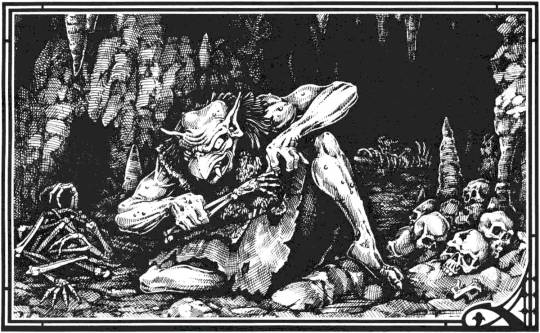
Sorting the moldering bones in the goblyn Caverns of the Dead (Ravenloft supplement Castles Forlorn, TSR, 1993; interior art is credited broadly to Stephen Fabian, Arnie Swekel, and Robert Klasnich -- I think this one looks like Swekel's)
#D&D#Dungeons & Dragons#Ravenloft#dnd#Arnie Swekel#goblyn#bones#skeletons#cave#cavern#Caverns of the Dead#Castles Forlorn#ossuary#grave#D&D 2e#AD&D 2e#Dungeons and Dragons#1990s#TSR
144 notes
·
View notes
Text




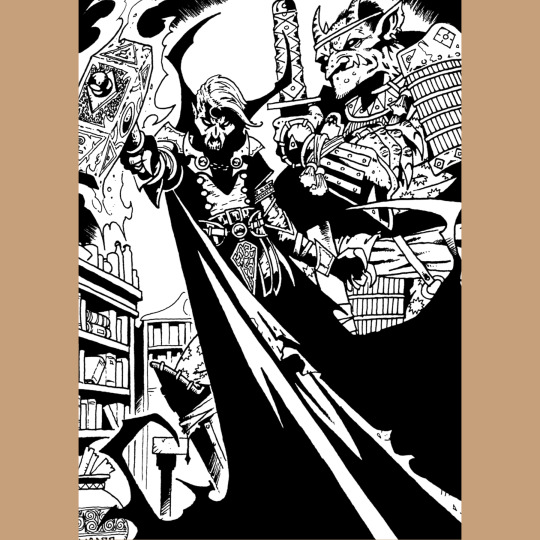
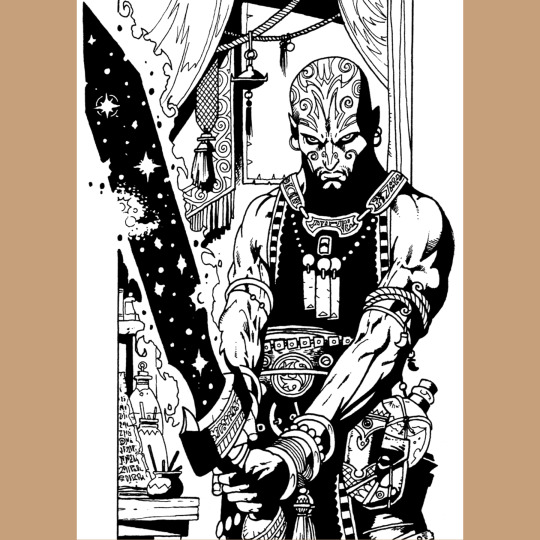
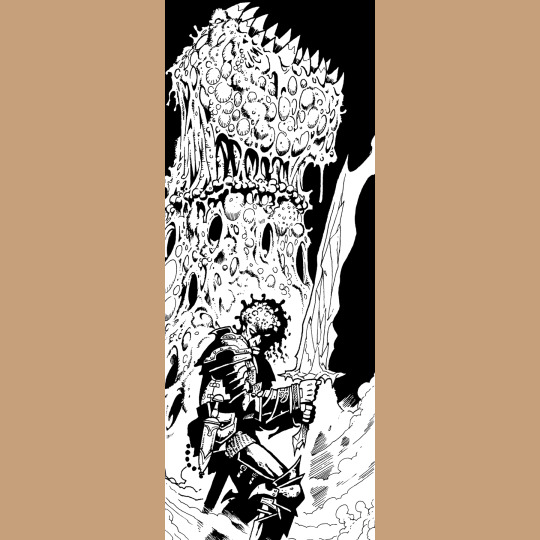
Return to White Plume Mountain (1999) is the fourth of TSR’s modules that return to classic adventure locations, and the third in in silver anniversary trade dress. Also the last of the both those things. Of the silver modules, it is my favorite (Return to the Tomb of Horrors is still my pick for the best of the lot though, probably).
Like Keep, this doesn’t include the original module, but reminagines the original space with twenty years of changes. It also takes pains to make a little more sense of the original module, which was a silly funhouse kind of dungeon that, while classic, is sort of a sore thumb in terms of Greyhawk lore. In fixing that, the designer actually strikes upon a surprisingly satisfying frame for the adventure.
Basically, the mountain was home to a mage named Keraptis, who left for parts unknown. Another mage took his name and home and, through a magical accident, an imprint of the original’s personality — this is the one who was heard but never seen in the original module. He’s dead now, but four others have been imprinted by artifacts the original mage left laying around. There are now four false kerapti — an efreet, an ogre mage, a mold wyrm (?) and a gnome — all with their own turf and control of one of the now four weapon artifacts housed in the volcano (Blackrazor, Whelm and Wave are joined by Frostrazor, an ice sword). Basically, four gangs loosed in a bizarro dungeon. What more can you really ask for? This dynamic really pushes White Plume Mountain into territory staked out in Jennell Jaquays’ Dark Tower, and I like it a LOT. And there is something far worse than the gangs under it all, to boot.
Cover by Arnie Swekel, redoing Erol Otus’ fairly iconic overland map. Interiors by Wayne Reynolds, settling into what will be the prime art seat for the imminent 3E.
105 notes
·
View notes
Text
Bloodsipper Podling
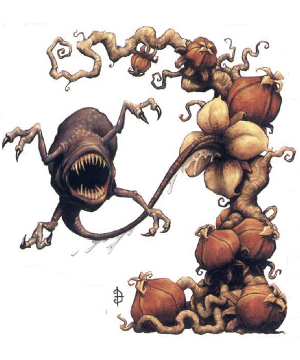
Image © TSR, inc. by Arnie Swekel.
[Commissioned by @coldbloodassassin. The bloodsipper first appeared in Gates at Firestorm Peak, the box set that introduced the Far Realm into D&D canon. I figure Leng is a suitable substitute in Pathfinder RPG. The original entry uses the vine as the primary source of stats, and the podlings as minions with abbreviated statistics. The vine itself has no ability to attack or move. I started this conversion as a vine-centric version, like the 2e one, before deciding that giving the podlings a full stat block and treating the vine as a terrain effect was more appropriate.]
Bloodsipper Podling
CR 3 N Aberration
This little horror looks something like a giant seed with no face except for a fanged maw. It has four limbs, each with two toes, which it seemingly uses as hands or feet interchangeably. It is connected to a pulsing yellowish vine by a tendril growing from its underside like an umbilical cord.
The bloodsipper vine grows in the cracks and crevices of the Plateau of Leng. A carnivorous horror somewhere between plant and animal, they use motile pods to grab onto passing creatures and drain them of their blood. They are tenacious and invasive, and can spread far and wide from a single nightmare to become an infestation. Once it is well fed enough, a bloodsipper vine can intentionally detach one of its pods. The freed podling hides itself in a quiet, dark place and erupts into a new vine growth in a matter of days.
The podlings of a bloodsipper usually hide inside its vegetative mass, concealed by the pods from which they grew or the coils of pulsing vines. They are blind, but can smell and detect movement with pinpoint accuracy, and when a creature approaches they launch themselves to the attack. A bloodsipper podling does not have any strategic abilities—they simply attach themselves to the first creature they can and drain blood, then repeat if other moving creatures are in the vicinity. Only a bloodsipper vine that is weak or injured will have a single podling—they are commonly found in whole squads. They are attached to their vines by an umbilical cord; if this is severed through violence, the podling slowly bleeds out.
Bloodsipper Vines
The vines from which bloodsipper podlings grow fill a 20 foot square with light undergrowth. They smell of blood out to 100 feet, which attracts carnivores and scavengers for the podlings to grab and drain. A podling can move through the area of a bloodsipper vine without penalty. The patch has 90 hit points, DR 5/slashing and the podling’s vulnerability to salt. The bloodsipper vine has no way of defending itself except through its podlings, but if the patch is burned, the smoke gives off a horrid stench in a 10 foot radius (as per a stinking cloud spell, CL 4th, DC 14).
Bloodsipper Podling CR 3
XP 800
N Small aberration (extraplanar)
Init +7; Senses blindsight 40 ft.,blind, Perception +6
Defense
AC 17, touch 14, flat-footed 14 (+1 size, +3 Dex, +3 natural)
hp 30 (4d8+12)
Fort +4, Ref +4, Will +5
DR 5/slashing; Immune gaze attacks, plant traits, visual spells and effects
Defensive Abilities floronic; Weaknesses tethered, vulnerable to salt
Offense
Speed 20 ft., climb 20 ft.
Melee bite +6 (1d8+3 plus grab)
Special Attacks blood drain (1d3 Con), grab (Large)
Statistics
Str 14, Dex 17, Con 16, Int 1, Wis 13, Cha 4
Base Atk +3; CMB +5 (+9 grapple); CMD 17
Feats Agile Maneuvers, Improved Initiative
Skills Climb +10, Perception +6, Stealth +12
Ecology
Environment any land (Plateau of Leng)
Organization solitary or grove (2-12)
Treasure incidental
Special Abilities
Floronic (Ex) Although it is an aberration, a bloodsipper podling has all of the immunities of the plant type. It is treated as both a plant and an aberration for the purposes of spells and effects.
Tethered (Ex) A bloodsipper podling cannot move more than 20 feet from the bloodsipper vine that is grows from (see above). Its vine can be severed with a successful sunder check made against the podling’s CMD with a slashing weapon (hardness 0, 5 hp), which removes the tether but deals 1 point of bleed damage to the podling.
Vulnerable to Salt (Ex) A handful of salt burns a bloodsipper podling as if it were acid, dealing 1d6 points of damage per use.
49 notes
·
View notes